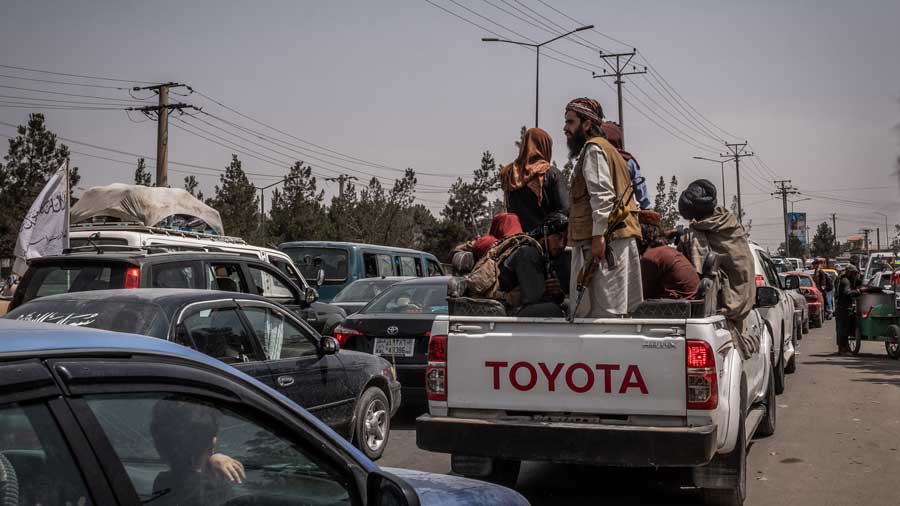Since last Monday, the international media and countless social media handles have been juxtaposing the dramatic images of Afghans trying to clamber on to a military aircraft of the United States of America in Kabul airport with 46-year-old images of a line of Vietnamese civilians getting into a helicopter parked near the US embassy in Saigon. Both images have a common theme: American defeat.
At the risk of anticipating developments, I would like to suggest that in the coming weeks and months, the images from Kabul are likely to be displayed alongside a very different set of photographs: the ball of fire engulfing the twin towers of New York City on September 11, 2001. This time, the message that will be conveyed will be significantly different: the triumph of jihad.
The reasons for the abrupt collapse of the Afghan State that was established after the military defeat of the Taliban in 2002 in the ‘War on Terror’ have been subjected to a great deal of analysis. The profound global concern over the fate of Afghans, particularly Afghan women, who had invested in the creation of a modern country, adhering to internationally-accepted norms and even a form of imperfect democracy, has been coupled with a measure of anger directed at the US administration. With the benefit of hindsight, it is now acknowledged that the abrupt exit of the US and other Western troops had a devastating impact on the morale of the Afghan National Army and led it to yielding ground to the ragtag Taliban forces without a fight. Whether the announcement of withdrawal on April 14 by President Joe Biden was premised on an overestimation of the Ashraf Ghani regime’s capacity to hold out against the Taliban or was simply a reflection of a couldn’t-care-less attitude of a declining power is certain to be the subject of future debate. There will, however, be unanimity over the fact that the billions of dollars spent on building Afghan capacity didn’t yield the desired political results. Without America’s hand-holding, the entire edifice collapsed like a pack of cards.
The despondency over the recapture of Afghanistan by the Taliban has been experienced all over the West and even in India, which, too, invested heavily in the building of a new Afghanistan. The focus is now likely to shift to the orderly rehabilitation of those Afghans who managed to get out of the country and concern for those Afghans whose social profile makes them anathema to the victorious Taliban. The example of post-1975 Vietnam suggests that the problem of Afghan refugees will preoccupy the West (and even India) in the coming years.
There is, however, another issue that is, for the moment, being overlooked amid the unfolding human tragedy of Afghans who want to get the hell out of the resurrected Emirate. How is the re-conquest of Afghanistan being viewed by those who waged a doughty jihad against American, British and other Nato forces for the past 19 years?
The issue is relevant because — at least until 2014 when the US and other powers reduced their boots on the ground drastically — the Taliban survived against formidable odds. The challenges that confronted the Taliban have been spelt out by Antonio Giustozzi in his well-researched book, The Taliban at War: 2001-2018. “During 2009-13 the Taliban stood against a much larger force, with the US contribution to the coalition amounting at one point to over 100,000 men. With US funds, the Afghan security forces increased to over 300,000 men by 2014, and US allies contributed tens of thousands of additional combat troops. The Taliban’s enemies, particularly the Americans, had immense superiority in terms of technology and firepower; airpower in particular inflicted heavy casualties on the Taliban. The Taliban mostly relied upon military technology from the 1950s, and had little or no anti-aircraft defences except heavy machine guns. During 2002-14 Taliban combat groups often took casualties averaging between 10-20 per cent yearly. By 2014, few of those who had entered the insurgency in the early years were still alive to tell the tale. Almost all still in the ranks, particularly in the elite mobile units, would have seen many of their comrades in arms blown to pieces. Whatever one might think of the Taliban and their cause, their resilience should not be in doubt.”
Having interviewed scores of Taliban fighters, Giustozzi also observed: “The Taliban claim that their moral righteousness, in serving the cause of Islam, has allowed them to surmount all these challenges.”
In short, as the larger consequences of the post-American world sink in, there is also likely to be a mythology that is certain to grow around the Taliban and their unflinching commitment to a jihad they believed in. For the moment, the visible celebrations over the Taliban victory may well be confined to some parts of Pakistan and in enclaves dominated by Palestinians. However, there is little doubt that the euphoria over the humiliation of America and the West is certain to generate a new wave of Muslim radicalization globally.
In an incisive study written in 2005, Landscapes of the Jihad, the Oxford academic, Faisal Devji, had observed that Osama bin Laden’s “jihad is global not because it controls people, places and circumstances over vast distances, for Al-Qaeda’s control of such things is negligible... but for precisely the opposite reason: because it is too weak to participate in such a politics of control... [T]he global consequences of Al-Qaeda’s jihad have outstripped its local causes, and so have exceeded its intentions, to take on a life of their own well beyond the politics of control.” In plain terms, global jihad of the type spawned by al-Qaida had been transformed into a hit-and-run operation after 2002. The recovery of Afghanistan has given Islamic jihad a State and a territorial base. The question is: will the resurrected Taliban regime oblige
Reacting to the Taliban takeover and mindful that the role of Pakistan is, once again, likely to come under international scrutiny, its prime minister, Imran Khan, argued that Afghanistan had broken the “shackles of slavery”. Positing the conflict in his neighbouring country as a cultural conflict, he said that Afghans had resisted a bid to make the country “psychologically subservient”.
Khan’s bid to project the Taliban as a personification of Afghan nationalism is understandable, and this is also how China would like it to be. What will be tested in the coming months is the extent to which groups in close ideological proximity to the Taliban factions visualize the future direction of Islamic reorientation. More important, will the Taliban 2.0 overcome their earlier urge to be a global nursery for jihadis all over the world?
This has a deep bearing on India’s national security since in the coming months there will be a concerted bid by sections of the Pakistani State apparatus to transform conflicts in the Kashmir Valley into an Islamist cause célèbre, on a par with Palestine. On its part, China is certain to use its new-found status as a Taliban-friendly world power to either encourage pressing the accelerator on Kashmir or demanding a price for applying the brakes.
For India, the Taliban victory in Afghanistan has brought new foreign policy and security challenges. At present, New Delhi’s old Northern Alliance friends are in disarray but they are certain to regroup and create enclaves of resistance to the Taliban. The choices are clear but difficult: unfriendly indifference or surreptitious encouragement of forces that will not be reconciled to a Taliban-controlled Afghanistan.
One chapter in Afghanistan’s troubled history has ended. A new one may be just beginning.











